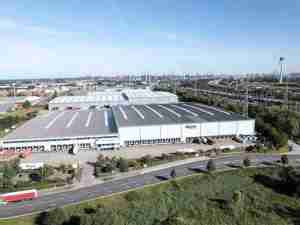Port of Vancouver USA commissioners approved agreements between the port and the BNSF Railway Company creating a historic transaction facilitating the construction of the port’s $137 million West Vancouver Freight Access project (WVFA) at the commission’s regular meeting.
The port will purchase nearly 17 acres of railroad right-of-way from BNSF for $3.1 million, and the railroad will donate more than $6 million of accompanying rail infrastructure to the port to allow the construction of the port’s preferred rail alignments. As a part of the deal, the port has agreed to finish construction of the project by December 31, 2017.
“This is an extremely significant agreement between the port and BNSF,” said the railroad’s Vice President of Network Development Pete Rickershauser, who flew in from Fort Worth, Texas for the meeting. “This port is in a unique situation to be ever more attractive to customers who need rail service. When a customer comes to the port and the railroads looking for a site, you are in a unique position.”
Rickershauser added that a US Department of Transportation study recently predicted nationwide, rail traffic would grow by 100 percent between 2005 and 2035.
“That speaks to the needs of this area,” Rickershauser said.
Port customers now use more than 57,000 rail cars annually. Recent studies forecast that rail use at the port could grow to as many as 160,000 rail cars per year when the project is complete and operating. The WVFA expands the dedicated port rail facilities from 18 miles of track to more than 43 miles, providing significant unit train improvements and marked capacity improvements to the Pacific Northwest railroad system that will benefit the region for years to come. Seventy percent of the port’s cargo is currently moved by rail, a number that’s expected to grow to more than 80 percent upon completion of the project. BNSF currently handles all rail services inside the port property, and delivers approximately 20 percent of port traffic for further handling by its competitor, Union Pacific Railroad (UP).
“We really appreciate that this is a significant milestone for BNSF, too,” said Port Commission President Brian Wolfe.
The agreement also opens the way for new commercial rail access for shippers within the port’s expanding marine and industrial facilities at Terminal 4, the Alcoa property (also known as the port’s future Terminal 5) and the future development at Columbia Gateway. As rail service continues to grow providing shippers commercial access to the mainline networks of both BNSF and UP is important. The partnership with BNSF, however, is memorialized in the agreement.
Some of the important deal points include a basis for the port to collect maintenance fees, rail infrastructure expansion repayment fees, access fees; support for existing port tenants including: Vestas, Subaru, Tristar Transload, Boise Building Products, Food Express, Commodities Plus, Plastics Northwest, Trimac Panel Products; and establishment of a stronger relationship between the port, as the rail owner, and the BNSF Railway as the port’s exclusive rail operator. This makes the railroad a vested marketing and operating partner with the port.
“This agreement provides the Port of Vancouver, for the foreseeable future, property that currently bisects the port’s properties, unit train access off of the mainline, and the ability to market, along with BNSF, the properties that it has in its plans for future expansion and growth, which will bring jobs to the community,” said Ann-Marie Lundberg of Tangent Services, one of the port’s independent advisers on the rail project.
Key next steps for the port and BNSF will be to jointly develop new customers to benefit from the rail expansion. The port will be delivering more than 600 acres of new space for marine and industrial use over the next 10-15 years, effectively doubling its size.
“Rail congestion will prevent us from expanding and it wil









